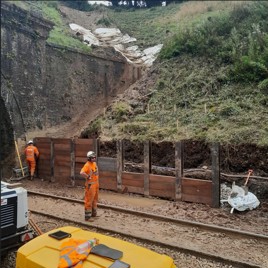A series of landslips blocked the West of England line at Honiton Tunnel intermittently for nearly a week from 20 August.
Mud and debris slumped down the steep slope to the track alongside the tunnel’s western portal.
A temporary fix using bags of stone ballast to hold back the flow of mud failed to keep the track clear.
The route was then blocked entirely for three days while engineers designed and installed a large timber barrier supported between steel piles.
The route finally reopened on August Bank Holiday with a 50mph speed restriction, although a further overnight closure followed for additional work.
There have been previous landslips at the other end of the tunnel.
Network Rail Wessex region said there had been “multiple” landslips. It said they were detected by movement sensors which triggered alarms.
A spokesperson said: “We believe this has been caused by an external ground water source.”
There had been no significant rainfall in the preceding days.
Mark Killick, engineering asset management director for Network Rail’s southern region, explained: “Tuesday afternoon saw a large volume of water coming out of the side of the slope, bringing with it lots of mud.
“This isn’t surface water, but water from deep within the ground. It’s proving really challenging to prove where the water is tracking from and how we can divert it.
“We’re building a permanent wall at the bottom. That involves drilling down six metres into the ground, putting big posts in and building a wall that will retain any further material coming down.”
Network Rail kept a watch team on site after the line reopened, in addition to remote monitoring, and confirmed that the source of the water was still unclear, a week after the landslip.
More extensive work during blockades at Honiton tunnel was already planned in September and October.
The Salisbury to Exeter Rail Users Group, SERUG, called SWR’s response “appalling.”
It criticised the “minimal effort” to provide Exeter to Honiton shuttle trains, despite no shortage of rolling stock stranded at the western end of the route.
It said passengers were “furious”. The landslip followed a prolonged period of short-formed trains due to engine reliability problems with the ageing Class 159 diesel fleet.
It said passengers were suffering bad experiences of rail travel with low resilience and little information. It added that passengers had complained of health issues caused by overcrowding.
SERUG said the first train through Honiton tunnel after the blockade was scheduled to be two cars in length, but was hurriedly doubled to four. The standard length of train on the route is six cars.
It said “everyone agrees” that the route needs new trains and more investment in better track and signalling, rather than the patch-and-mend approach of recent years.
A landslip closed the West of England line at Crewkerne for a week last December, following heavy rainfall. 100 tonnes of clay, soil and vegetation had to be removed from the entrance to Crewkerne tunnel.
The West of England line had also been closed for 16 days last autumn for improvement work.
















Login to comment
Comments
No comments have been made yet.